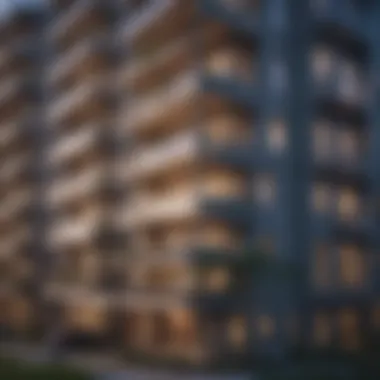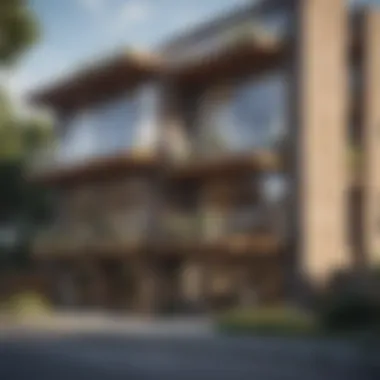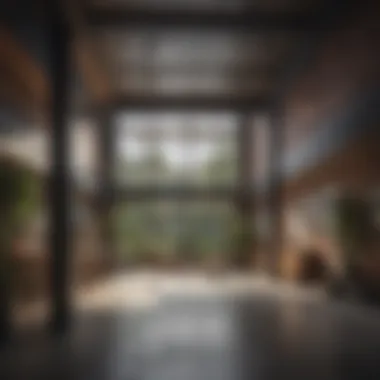The Multi-Unit Building: An In-Depth Exploration


Intro
Understanding the landscape of urban living requires a deeper examination of multi-unit buildings. These structures are not just mere collections of residences; they embody significant architectural elements that reflect the changing nature of urban environments. Multi-unit buildings serve various functions and can be found in different forms, from high-rise apartments to townhouses. This article presents an analytical glimpse into the attributes of these buildings, pinpointing their advantages and challenges while addressing critical themes such as sustainability and community dynamics.
The multi-unit building phenomenon responds to urbanization and the increasing demand for housing. As populations grow and land becomes scarcer, it is essential to consider how these buildings can meet contemporary needs while enhancing urban aesthetics and fostering community engagement. Investors and homeowners alike will find valuable insights into not just the properties themselves, but also the broader implications of their existence in our cities.
Understanding Multi-Unit Buildings
Multi-unit buildings are a crucial component in the landscape of urban development. Their significance extends beyond mere architectural form; they play a vital role in addressing housing shortages and promoting diverse community settings. Understanding these structures involves exploring their definitions, characteristics, and the historical circumstances that led to their rise in prominence. This section lays a foundational framework for appreciating how these buildings fit within the broader context of modern living.
Definition and Characteristics
Multi-unit buildings, as the term suggests, accommodate multiple residential units within a single structure. This category includes various types such as apartment complexes, condominiums, and townhouses, each with unique features.
Characteristics typically associated with multi-unit buildings are:
- Shared infrastructure: Residents often share amenities like hallways, elevators, and communal spaces, fostering community interaction.
- Diverse unit sizes: Multi-unit buildings often feature a range of unit sizes, appealing to various demographics from single occupants to families.
- Compliance with zoning regulations: These buildings must adhere to specific local zoning laws, which dictate height, density, and land use.
- Ownership models: Ownership varies; some units are rental properties while others are owned individually, creating different business and investment dynamics.
Through these elements, multi-unit buildings not only serve functional needs but also shape urban landscapes, influencing everything from social interactions to economic viability.
Historical Context
The evolution of multi-unit buildings is intricately tied to urbanization trends and demographic changes.
In the late 19th and early 20th centuries, rapid urbanization due to industrialization created a need for affordable housing solutions. Cities became crowded, leading to the development of tenements and apartment buildings. These structures provided necessary shelter for workers and their families, though often with inadequate living conditions.
Post-World War II saw a shift with the advent of planned communities, emphasizing modern design and functionality. The need for housing solutions remained constant, prompting the rise of gated communities and condominiums in the late 20th century. Today, the design and planning of multi-unit buildings are guided by a combination of historical lessons and contemporary desires for both sustainable practices and community-oriented living.
Understanding these historical perspectives is essential, as they inform current discussions about housing trends, community needs, and regulatory frameworks.
Types of Multi-Unit Buildings
Understanding the different types of multi-unit buildings is essential for various stakeholders in real estate, including investors, homeowners, and urban planners. Each type brings unique characteristics and benefits that influence their investment potential and suitability within specific urban contexts. Exploring these types can provide clarity on living options and can guide decisions related to purchasing, renting, or investing.
Apartment Complexes
Apartment complexes are perhaps the most common form of multi-unit living. They typically consist of several rental units grouped together into one or more buildings. The layout often includes shared amenities such as laundry facilities, swimming pools, and community spaces.
One key benefit of apartment complexes is affordability. They can offer lower rent compared to detached homes or single-family residences, making them ideal for individuals and families seeking economical housing options. Apartment complexes often attract a diverse demographic, providing community engagement opportunities among residents.
However, it is important to acknowledge potential challenges such as sharing common spaces, which may lead to conflicts among tenants regarding noise or maintenance issues. Furthermore, management is crucial in maintaining the building and facilitating a positive living environment.
Condominiums
Condominiums, often referred to as condos, represent a distinctive form of multi-unit living where individuals own their units while sharing ownership of common areas such as hallways, roofs, and amenities. This ownership structure often provides a sense of community while retaining privacy.
Condominiums attract those who desire homeownership without the responsibilities associated with a single-family home. Many condos come with amenities like gyms, rooftop terraces, and security services, enhancing their appeal.
A drawback to consider is the presence of homeowner association fees, which can vary significantly depending on the location and services offered. These fees can add an ongoing financial obligation for condo owners, which should be accounted for when evaluating the overall cost of ownership.
Townhouses
Townhouses are another popular form of multi-unit building characterized by attached units that typically have multiple floors. They often come with private entrances and sometimes small yards, offering a blend of convenience and privacy.
The design of townhouses allows for effective land use, making them suitable for urban environments where space is limited. They can provide more square footage compared to apartments, which appeals to families or individuals seeking more room.
However, while townhouses offer proximity to neighbors, they also carry some considerations like shared walls. This aspect can affect noise levels and privacy. Additionally, community regulations may dictate the external appearance and modifications to units, which could be a downside for those valuing personal expression in their living space.
Zoning Regulations and Compliance


Zoning regulations play a critical role in the development and functionality of multi-unit buildings. These laws govern land use, ensuring that various types of properties harmonize within a community. Understanding zoning regulations is essential not only for developers but also for homeowners and investors involved in real estate. They dictate the types of structures allowed, their densities, and how they must be set back from property lines. Compliance with these regulations ensures the safety, aesthetic quality, and value preservation of neighborhoods.
Broadly speaking, zoning can affect:
- Property Value
- Community Structure
- Environmental Impact
The benefits of adhering to zoning laws are significant. They can help in promoting efficient use of land and resources, encouraging infrastructure development, and fostering community relations. Without strict compliance, one might witness overcrowding, insufficient access to services, and declining quality of living conditions.
Understanding Zoning Laws
Zoning laws can be complex, often varying between municipalities. These laws categorize land within certain zones, each with designated purposes such as residential, commercial, or industrial.
Key Elements of Zoning Laws
- Land Use Classification
This determines what types of buildings can be constructed on a piece of land. - Density Limits
These dictate how many units can be built per area, influencing the height and number of stories allowable in multi-unit buildings. - Setback Requirements
Setback regulations specify how far a building must be from the property line, affecting outdoor space.
Understanding these classifications helps in planning and can prevent costly mistakes during the development process.
Impact on Design and Layout
Zoning regulations significantly influence the design and layout of multi-unit buildings. Developers need to adapt their plans based on local zoning laws, which in turn shapes architectural aesthetics and spatial organization.
- Architectural Style
Depending on zoning requirements, the look of a building may be constrained to certain styles to maintain neighborhood aesthetics. - Unit Configuration
Zoning can restrict how units are arranged, whether through clustering or linear designs, affecting the overall functioning of the building. - Common Areas and Amenities
Regulations often set parameters for shared spaces, promoting a sense of community while ensuring safety and accessibility for all residents.
By understanding and adhering to zoning regulations, developers can create well-integrated multi-unit buildings that enhance urban landscapes and fulfill community needs.
Construction Methods
Construction methods are fundamental in shaping the functionality, sustainability, and aesthetic appeal of multi-unit buildings. The choice of construction technique affects not only the speed of execution but also long-term operational costs and environmental impact. This section delves into traditional techniques, innovative materials, and sustainable practices, illustrating their significance in modern multi-unit housing.
Traditional Construction Techniques
Traditional construction methods such as masonry, wood framing, and concrete casting have stood the test of time. These techniques have proven effective in creating strong and durable structures that can endure various environmental conditions.
- Masonry: This method involves stacking bricks or blocks and using mortar for cohesion. It is known for robustness and fire resistance.
- Wood Framing: Often popular in residential buildings, wood framing offers flexibility in design. It is easily customizable, which can be a significant advantage during construction.
- Concrete Casting: This technique utilizes poured concrete, allowing for complex designs. It offers excellent sound insulation and is energy-efficient when appropriately used.
Each traditional technique has its own set of benefits. Selecting the right method often depends on factors like climate, budget, and desired aesthetic.
Innovative Building Materials
In recent years, the building industry has witnessed a growing inclination towards innovative materials. These materials not only enhance construction efficiency but also address sustainability concerns.
- Cross-Laminated Timber (CLT): An engineered wood product, CLT poses a viable alternative to concrete. It is lighter, easier to work with, and has superior environmental benefits.
- Insulating Concrete Forms (ICFs): These forms provide excellent thermal insulation and structural integrity. They can significantly lower energy costs in multi-unit buildings.
- Recycled Materials: Using recycled materials, like reclaimed wood or recycled steel, contributes to sustainability. This can also reduce waste and lower material costs.
Innovation in materials has transformed construction methods, allowing for faster builds while reducing environmental impact.
Sustainable Practices in Construction
Sustainability is no longer an option but a necessity in modern construction. Multi-unit buildings are increasingly expected to adhere to sustainable practices, balancing efficiency with environmental stewardship.
- Energy-Efficient Systems: Incorporating systems such as solar panels and efficient HVAC can drastically reduce a building’s carbon footprint.
- Water Conservation Techniques: Installations like rainwater harvesting systems lead to significant water savings.
- Green Certifications: Programs like LEED (Leadership in Energy and Environmental Design) encourage builders to adopt energy-efficient practices and materials.
"Sustainability practices not only enhance a building’s appeal but also increase its long-term value."
Overall, the application of sustainable practices in construction can enhance community well-being, decrease operational costs, and contribute to a healthier environment. By focusing on these methods, developers can create multi-unit buildings that are not only functional but also responsible and resilient.
Implications for Urban Living
Multi-unit buildings play a crucial role in shaping urban environments. As cities grow and expand, the need for efficient use of space and resources becomes paramount. Multi-unit structures address this by providing housing solutions that cater to diverse populations while also preserving valuable land. This section delves into the specific elements of density and community dynamics, as well as access to amenities and services, emphasizing the multifaceted benefits that these buildings offer to urban living.


Density and Community Dynamics
Increased density is one of the most significant implications of multi-unit buildings in urban settings. Higher density can foster vibrant communities, where residents are more likely to engage with one another. This interaction cultivates a sense of belonging that is often harder to achieve in more isolated residential formats, such as single-family homes.
However, challenges accompany density. Noise, congestion, and the strain on infrastructure can become prominent issues. Proper planning and management can mitigate these disadvantages. For example, ensuring sufficient green spaces or community areas can greatly enhance the livability of densely populated neighborhoods.
The proximity of various socio-economic groups also enriches community dynamics, promoting inclusivity. As neighborhoods diversify, cultural exchanges and interactions can lead to increased creativity and social cohesion.
Access to Amenities and Services
Multi-unit buildings often provide residents with easier access to essential amenities and services. Proximity to workplaces, restaurants, shopping centers, and recreational areas amounts to immeasurable convenience. This accessibility is particularly beneficial in urban areas where traffic congestion is generally high.
In major cities, multi-unit housing often comes with on-site amenities such as gyms, pools, and communal spaces. Such features encourage a sense of community among residents, making it easier for them to socialize and establish connections.
Furthermore, these buildings support public transportation systems by being strategically located near transit hubs. Immediate access to mass transit not only reduces reliance on personal vehicles but also eases overall traffic conditions in urban areas. The following advantages underscore the importance of accessibility in multi-unit buildings:
- Reduced travel time for residents
- Environmental benefits through decreased vehicle emissions
- Increased local business revenue due to foot traffic
"The integration of multi-unit buildings in urban areas is not merely a housing solution; it is a stepping stone towards more interconnected, vibrant, and sustainable communities."
Advantages of Multi-Unit Buildings
Multi-unit buildings provide several significant benefits that influence urban living. Their importance in today's housing landscape cannot be overstated. They serve as an alternative to single-family homes, addressing housing shortages in dense metropolitan areas while providing unique opportunities for both renters and investors.
Affordability and Accessibility
One of the primary advantages of multi-unit buildings is their affordability. These structures often allow for lower rental and purchase costs compared to standalone homes. Prices are typically lower due to shared walls, less land, and the ability to house more units within the same footprint. This scenario makes homeownership more achievable for individuals and families, especially in expensive urban areas.
Moreover, multi-unit buildings frequently offer varied sizes and configurations. This flexibility appeals to a diverse audience. Young professionals, families, and retirees—each can find a suitable living arrangement. The communal nature of these buildings often enables residents to live within close proximity to essential amenities such as grocery stores, parks, and public transport. This enhances overall accessibility, reducing reliance on cars and promoting a more sustainable lifestyle.
"Multi-unit buildings can help tackle the housing crisis by providing accessible options that cater to diverse lifestyles and incomes."
Efficient Use of Space
Efficient spatial design is another hallmark of multi-unit buildings. Unlike traditional homes that require significant lot space, these structures maximize the utility of land. By stacking units vertically or arranging them in compact forms, developers utilize every square foot available.
This careful planning leads to the following benefits:
- Optimized Land Use: Multi-unit buildings contribute to urban infill, minimizing urban sprawl. They make better use of existing infrastructure.
- Community Cohesion: The design of these buildings often fosters interaction among residents, nurturing a sense of community. Shared spaces like gardens or lounges can promote social interaction and collaboration.
- Reduced Environmental Impact: Smaller living spaces often lead to reduced consumption of resources—electricity, water, and heating. This aspect aligns with sustainability goals, making multi-unit buildings a favorable choice for future urban development.
These factors together depict why multi-unit buildings stand out as a smart solution in today’s real estate landscape. Their affordability, accessibility, and efficient use of space indicate not just benefits to individuals, but also broader implications for urban culture and environmental sustainability.
Challenges and Disadvantages
In any discussion about multi-unit buildings, addressing challenges and disadvantages is paramount. Understanding these aspects allows investors, homeowners, and design professionals to make informed decisions. While multi-unit buildings offer various benefits, they also come with their unique set of challenges that need careful consideration.
Maintenance and Upkeep
One of the most significant challenges associated with multi-unit buildings is maintenance and upkeep. As these structures house multiple families or tenants, the responsibility for maintenance can often fall on property management or homeowners’ associations. This can lead to conflicts regarding priorities and resource allocation.
Regular maintenance requires consistent attention to different areas such as plumbing, heating, and electrical systems which can be complex due to the shared nature of these facilities. Also, wear and tear in common areas often necessitates increased attention. Failing to effectively manage maintenance can lead to dissatisfaction among residents, decreased property values, and even potential safety hazards.
To alleviate these challenges, it's crucial to implement a structured maintenance plan that includes routine inspections, prompt repairs, and clear communication with residents. This approach not only enhances tenant satisfaction but also contributes to the longevity of the building.
Regulatory Hurdles
Regulatory hurdles can pose significant challenges for multi-unit buildings. Zoning laws often dictate where, how, and under what conditions multi-unit structures can be developed. These regulations can vary greatly between jurisdictions, leading to complexities in the planning and approval process.
Developers must navigate through a web of local ordinances, occupancy permits, and building codes. Delays in securing the necessary permits can stall construction or renovations, increasing costs and extending project timelines. Moreover, failure to comply with these regulations can result in hefty fines or even legal action.


It is essential for real estate investors and developers in this sector to work closely with legal experts and local government authorities. This helps ensure that all compliance requirements are adequately addressed. Staying informed about changes in zoning laws or building codes can also mitigate future regulatory challenges.
Future Trends in Multi-Unit Housing
The landscape of multi-unit housing is continuously evolving. As urban populations rise, the demand for efficient living spaces grows. Understanding future trends in this area is crucial for stakeholders like investors, homeowners, and city planners. These trends not only influence the design and construction of multi-unit buildings but also impact the way communities function in urban settings.
Smart Building Technology
The integration of smart building technology in multi-unit housing represents a significant trend. Smart technology includes systems and devices that enhance the living experience. Examples are smart thermostats, lighting systems, and security features. These innovations provide benefits such as energy efficiency and improved security.
Incorporating smart technologies can also lead to reduced operational costs. For example, residents can control energy use through smart meters, leading to lower utility bills. Additionally, property managers can monitor system performance remotely, ensuring timely maintenance and reducing downtime.
The app design for controlling these features is becoming more user-friendly. Residents can interact with these systems easily through smartphones, increasing the appeal of properties that utilize such technology.
Smart buildings are the future of urban living, combining efficiency with convenience, benefiting both residents and property owners.
Sustainability and Environmental Impact
Sustainability is another critical factor shaping future multi-unit housing trends. As awareness of environmental issues grows, so does the demand for eco-friendly building designs. Sustainable practices can reduce the carbon footprint of multi-unit buildings significantly. This includes using renewable energy sources, sustainable materials, and efficient waste management systems.
Incorporating green roofs, improved insulation, and energy-efficient appliances are ways to promote sustainability. For instance, buildings designed with green roofs provide insulation, reduce heat absorption, and foster biodiversity. These features not only enhance the aesthetic appeal of buildings but also contribute positively to the environment.
Moreover, the local community benefits from these practices by promoting healthier living conditions. Residents enjoy cleaner air and lower energy costs while contributing to the fight against climate change. Regulatory bodies are increasingly supporting these initiatives as part of urban planning policies.
In summary, future trends in multi-unit housing point toward integration of smart technology and sustainability. Both trends enhance living quality and operational efficiency, making them essential considerations for developers and investors.
The Role of Multi-Unit Buildings in Real Estate Investment
Multi-unit buildings play an essential role in the realm of real estate investment. As an investor, understanding this category of properties can unlock numerous opportunities and drive wealth accumulation. This section aims to highlight the specific elements of multi-unit buildings that make them advantageous in the context of real estate.
Real estate investment often involves balancing risk with potential returns. Multi-unit buildings generally offer lower risks compared to single-family homes. This is due to their capacity to generate multiple streams of rental income. Investors can spread their risk across various tenants, minimizing the impact if one unit becomes vacant. Furthermore, the demand for multi-unit housing continues to increase in urban areas, making these properties a vital part of the housing market.
Investment Analysis
In evaluating the investment potential of multi-unit buildings, several factors need to be considered. First, the location significantly influences property value. Properties situated near amenities such as schools, shopping centers, and public transport tend to appreciate more over time. Additionally, understanding the local rental market is crucial. Factors such as average rental rates, vacancy rates, and tenant demographics provide insights into the property's earning potential.
Another critical aspect involves assessing operating expenses. Multi-unit buildings typically incur costs such as maintenance, property management, and utilities. It is advisable to analyze these expenses thoroughly. A common approach is to calculate the Net Operating Income (NOI), which can provide a clearer picture of profitability. This figure is derived by subtracting total operating expenses from gross rental income. A higher NOI often indicates a good investment.
Lastly, investors should be aware of financing options available for multi-unit properties. Traditional mortgages, FHA loans, and commercial loans are some of the avenues that investors can explore. Each option may have its own qualification criteria and interest rates, affecting the overall return on investment.
Long-Term Value Considerations
Long-term value considerations for multi-unit buildings encompass various aspects that contribute to sustained appreciation and profitability. One of the foremost elements is market trends. Observing the historical performance of properties in the area and potential future developments can aid in making informed decisions. Areas with planned infrastructure projects may see significant increases in property values.
Another important factor is property management. Efficient management can enhance tenant satisfaction and retention, thereby stabilizing revenue. Regular maintenance and timely repairs protect the property’s condition and increase its longevity, which ultimately improves its marketability.
Physical upgrades to the property can also enhance long-term value. Renovations such as updating kitchens, improving energy efficiency, or adding communal spaces can attract higher-quality tenants and justify increased rents.
Moreover, effective marketing strategies that emphasize the benefits of living in a multi-unit building can help maintain occupancy levels. Targeting groups such as young professionals, families, or students allows owners to fill vacancies more quickly and maximize income.
> Investing in multi-unit buildings can provide a safer pathway towards wealth accumulation, while also addressing housing needs in urban environments.
End
The conclusion of this article emphasizes the critical role that multi-unit buildings play in the contemporary housing market. It encapsulates the primary elements discussed throughout the various sections. These elements outline the significance of understanding the architecture, types, and regulations associated with these buildings. Furthermore, it highlights the implications for urban living and real estate investments.
Multi-unit buildings serve as a solution to growing housing demands in urban areas. Their design helps to optimize space and resources, which is crucial in densely populated regions. The integration of smart building technology and sustainable practices is particularly relevant, addressing the need for environmental responsibility. By evaluating the advantages and disadvantages, the reader gains a complete view of the factors influencing multi-unit living.
Summary of Key Points
- Definition and Significance: Multi-unit buildings are essential for meeting urban housing needs.
- Types: Diverse forms including apartment complexes, condominiums, and townhouses accommodate different demographics and preferences.
- Zoning Regulations: Understanding zoning laws is crucial for compliance and design planning.
- Construction Practices: Both traditional methods and innovative materials shape the construction landscape.
- Advantages: Cost-effectiveness and space efficiency make multi-unit options appealing to many residents.
- Challenges: Maintenance needs and regulatory hurdles can complicate ownership and management.
- Future Trends: Emphasis on smart technologies and sustainability reflects modern priorities.
Final Thoughts on Future Prospects
The future of multi-unit buildings appears promising. As urbanization continues to rise, the demand for innovative housing solutions will increase. Developers are likely to focus more on integrating smart technology into building designs. This can enhance functionality and energy efficiency.
Additionally, sustainability will drive changes in construction practices and materials used. An ongoing commitment to environmentally friendly practices will likely become a standard expectation rather than an exception.







